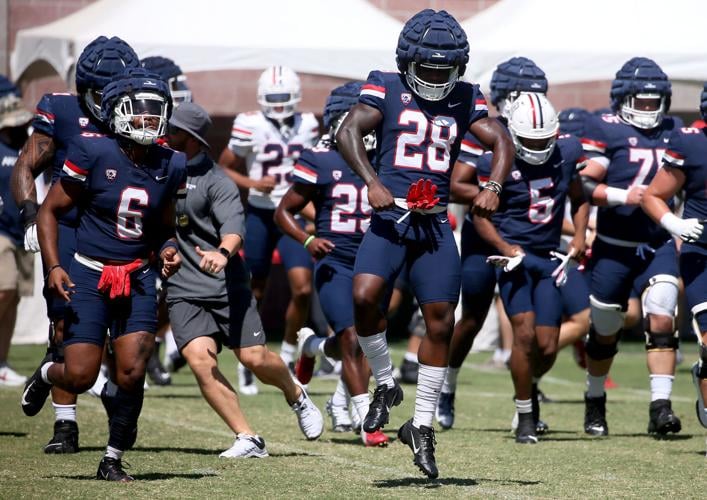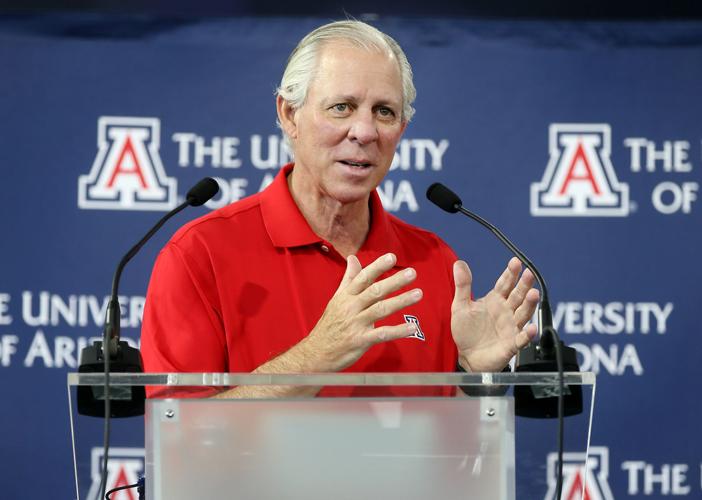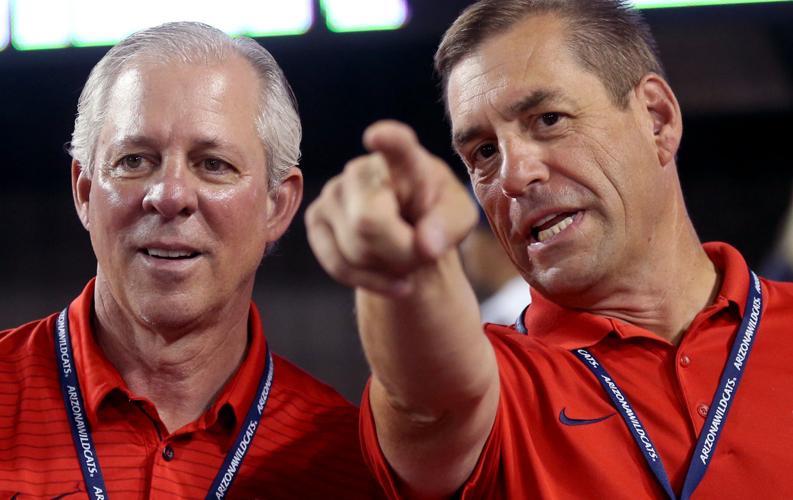The University of Arizona is officially part of the Big 12 conference.
In a move that has felt almost inevitable in recent days, the UA finalized its departure from the Pac-12 — the conference it has called home since 1978 — Friday evening.
Big 12 officials met Thursday to approve the addition of Arizona as its 14th member, per reports, paving the way for a new era of UA athletics.
It’s not just Arizona that’s leaving the Pac-12 behind, though. Arizona State, the Wildcats’ chief rival, and Utah were approved by the Big 12 Friday and collectively announced by the conference as its 15th and 16th members, alongside Arizona, Friday night.
That news came just hours after the Big Ten officially accepted Washington and Oregon as its 15th and 16th members Friday afternoon. The Pacific Northwest schools’ first official day as Big Ten members will be Aug. 2, 2024.
All told, 2023-24 will be the final season in the Pac-12 for Arizona, ASU, Utah, Oregon and Washington.
The same goes for Colorado, which left for the Big 12 last week, and USC and UCLA, which announced their move to the Big Ten last summer.
The overlapping moves put the future of the 108-year-old Pac-12 Conference in crippling doubt.

University of Arizona President Robert C. Robbins, left, and UA athletic director Dave Heeke wer charged of late with determining if the Big 12 provided a better long-term future for Arizona sports than sticking with the Pac-12. They determined it did.
“We are thrilled to welcome Arizona, Arizona State and Utah to the Big 12,” Big 12 Commissioner Brett Yormark said in a release. “The conference is gaining three premier institutions both academically and athletically, and the entire Big 12 looks forward to working alongside their presidents, athletic directors, student-athletes and administrators.”
Arizona football coach Jedd Fisch said at his team’s first open practice ahead of the 2023 season that he’s told his players they “are literally living through history” not only in regard to conference realignment, but other events significantly impacting college sports on a national level in recent years.
“If you think about the guys that played college football from, let’s call it 2020 to 2025, you lived through a pandemic and how that worked in college football — the uniqueness in playing in front of no one. You went through transfer portal rules that nobody ever thought would ever happen,” he said.
Fisch added that the implementation of new “NIL” rules, which allow college athletes to utilize their own name, image and likeness for marketing purposes for their own previously disallowed financial benefit, and conference realignment only add to the historical element of the current era of college athletics.
“You started getting paid, and now you’re sitting there looking at conferences that were historically a group of 12, 10, 10, 12 — whatever they were — turning into 16-team mega-conferences,” he said. “The Big Ten is getting bigger and bigger from what I understand. The SEC is doing their deal bringing in Texas and Oklahoma. Whatever happens with us will happen with us.
“It’s a change. Everything is just new. It’s truly a new frontier of college football,” Fisch added. “I love it.”
Neither ASU nor Utah had seemed as aggressive as Arizona in pursuing an escape route from the crumbling Pac-12, but momentum shifted multiple times late in the week and into Friday.
Stanford, Cal, Oregon State and Washington State are, in effect, all that’s left of the Pac-12 at this point, although the Bay Area schools have also been rumored to be on the Big Ten’s radar.
It would seem the most viable option for either those remaining schools on their own, or for the conference via a partnership or merger, to link up with the Mountain West Conference, where their chances of winning conference championships would improve but their media revenue would plummet.
“We are disappointed with the recent decisions by some of our Pac-12 peers,” Washington State President Kirk Schulz and athletic director Pat Chun said Friday in a joint statement, per the Associated Press. “While we had hoped that our membership would remain together, this outcome was always a possibility, and we have been working diligently to determine what is next for Washington State athletics. We’ve prepared for numerous scenarios, including our current situation.”

Arizona State president Michael Crow has been reluctant to pull the Sun Devils out of the Pac-12, but with the league on the verge of collapse, he might have no choice.
Washington athletic director Jennifer Cohen said in a statement her university has “tremendous respect and gratitude for the Pac-12, its treasured history and traditions. At the same time, the college athletics landscape has changed dramatically in recent years.
“The Big Ten’s history of athletic and academic success and long-term stability best positions our teams for future success,” she added.
Stability has been a sticking point for Pac-12 campus leaders, as UA President Robert C. Robbins said multiple times this year that the figures presented by the conference for its next media-rights deal would dictate whether the UA stayed or sought something more lucrative. Pac-12 commissioner George Kliavkoff finally showed his cards this week, revealing a streaming-centric deal with Apple that fell well short of the $31.7 million that Arizona can receive annually from the Big 12. The latter agreement is with ESPN and FOX, providing greater exposure than any streaming outlet could generate.
Pac-12 campus leaders met again Friday to hear an update from Kliavkoff. It was seemingly a last-ditch effort to keep what were the nine remaining Pac-12 schools at that point together.
But not long after Friday’s meeting, ESPN, Yahoo Sports and other national outlets reported that talks between Washington and Oregon to also leave the Pac-12 — in their case, joining USC and UCLA in the Big Ten — were not just on but close to an agreement. By mid-afternoon, Yahoo reported the “Big Ten is in the final stages of negotiating an expansion to 18 teams” by adding UW and UO to the mix, with ESPN’s confirmation of the Big Ten’s definitive OK coming not much later.
Yahoo also reported that both schools are “expected to agree to a cut rate — perhaps as low as 50% — of the Big Ten’s media revenue that could reach $65 million/year per institution.”
That number for Oregon and Washington, however, would still be higher than what Yahoo reports Kliavkoff presented to Pac-12 presidents for the Apple deal — “estimated to be in the $20-25 million range.” Other reports had the revenue numbers at around $30 million with $1 million per year increases for both schools.
Arizona football assistant coach Chuck Cecil, a legend in his playing days in Tucson, shares at the team's media day Aug. 1, 2023 the importance of the UA/ASU rivalry amid the college realignment conversation. Video by Brett Fera/Arizona Daily Star
Michael Lev column: Colorado’s move to the Big 12 is the latest sign that the Pac-12 is sinking fast; Arizona should join CU in jumping ship to the Big 12.
Michael Lev: We all wanted to talk football at Arizona football media day, but realignment — and its potential side effects on a storied rivalry — kept creeping into the conversation.










